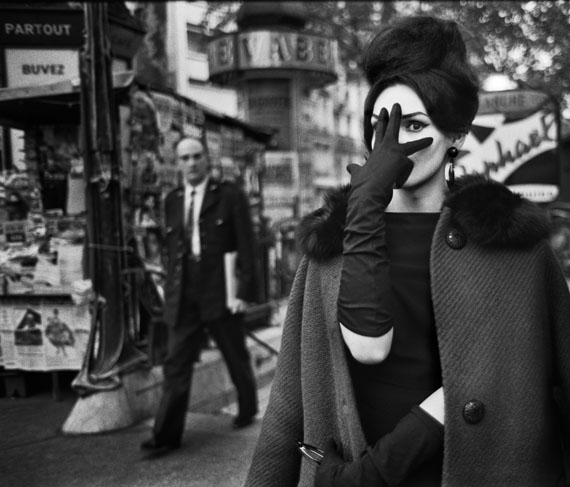
© Christer Strömholm Estate, 2016
EYES OPEN! 100 YEARS OF LEICA PHOTOGRAPHY
AUGEN AUF! 100 Jahre Leica Fotografie
Bernd Arnold » René Burri » Henri Cartier-Bresson » Bruce Davidson » William Eggleston » Ilja Ehrenburg » Alfred Eisenstaedt » Robert Frank » Bruce Gilden » George Grosz » Fred Herzog » Thomas Hoepker » William Klein » Viktor Kolář » Gilles Larrain » Ulrich Mack » Ramón Masats » Alexander Rodchenko » Anton Stankowski » Christer Strömholm » & others
Exhibition: 9 Mar – 5 Jun 2016
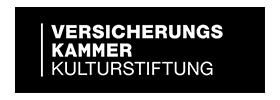
Kunstfoyer
Maximilianstr. 53
80530 München
+49 (0)89-2160 2244
kunstfoyer@vkb.de
www.versicherungskammer-kulturstiftung.de
daily 9:30 - 18:45
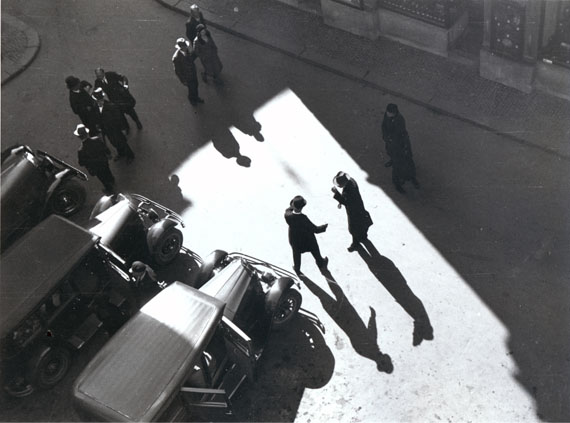
© Stankowski-Stiftung
"EYES OPEN! 100 YEARS OF LEICA PHOTOGRAPHY"
Exhibition: 9 March – 5 June, 2016
This camera changed the way we view the world. Forever. The falling soldier by Robert Capa, the puddle jumper by Henri Cartier-Bresson, the Times Square kiss by Alfred Eisenstaedt, Vietnamese children fleeing from a Napalm attack by Nick Út, the Soviet flag being raised above the Berlin Reichstag by Yevgeny Khaldei – all these famous photographs are Leica images, and they have etched themselves deeply into our collective memory. It was the Leica’s compactness and innovative technology that made photographs like these possible. The Leica’s predecessors were, for the most part, clumsy, heavy cameras. They were unwieldy and designed to yield one photograph per glass negative. It was nearly impossible to use them in a spontaneous manner. Before the advent of the Leica, taking photographs amounted to a staging of reality. The compact Leitz camera made spontaneity as well as candid street photography possible.
Dynamization, democratization, media revolution – great cultural changes are often attributed to technical innovations, and the introduction of the Leica 100 years ago is no exception. Just how can a small, black gadget produce such a superlative effect? Its pocket size, exchangeable lens, quiet operation, and fast shutter speeds made completely new fields of application, extreme angles, and spontaneity on an unheard-of scale became available to the photographer. Thanks to its use of standard cinema film, photography became a serial operation, affordable and available to everyone. The speed, freedom, and ease of operation it provided were a source of inspiration to photographers, and it met the needs of a dynamic age. Easily carried in one’s coat pocket, the camera sparked an enormous surge in photography, an immense sense of joy in experimentation, and an all-encompassing visual exploration of reality. The Leica thus set the standard for new horizons, speed, and aesthetic renewal, and it has retained its mythical status well into the digital age.
The exhibition "AUGEN AUF! 100 JAHRE LEICA FOTOGRAFIE" (EYES OPEN! 100 YEARS OF LEICA PHOTOGRAPHY) casts a light on many aspects of small-format photography. Divided into sixteen chapters, it ranges in scope from journalistic strategies to documentary approaches right through to unfettered artistic expression. Viewing photography from the perspective of art and cultural history for the first time, it illustrates how the Leica compact camera changed photographic vision in the 20th century. More than 300 photographs from international collections and museums as well as newspapers and significant photobooks document the various aspects of Leica photography from the mid-1920s on. The exhibition thus provides a stylistic history of the medium, running the gamut from the classic modern age to the post-modern diversity of the present day, from New Vision via “la photographie humaniste” to fashion photography, from “subjective photography” via author photography to street photography and contemporary art photography.
For this exhibition, Kunstfoyer Munich has brought together works by internationally renowned Leica photographers such as Alexander Rodchenko, Henri Cartier-Bresson, Robert Capa, Christer Strömholm, Bruce Davidson, F.C. Gundlach, Fred Herzog, Robert Lebeck, William Eggleston, Will McBride, Paolo Roversi, René Burri, Thomas Hoepker, Bruce Gilden, Mark Cohen, Nobuyoshi Araki, and many others.
The name Leica came about by combining the first letters of the words Leitz and camera. The original model was built by precision mechanic and amateur photographer Oskar Barnack in March 1914, and he immediately succeeded in capturing absorbing images on 35 mm cinema film. Barnack enlarged the size of the standard cinema negative to 24 x 36 mm, and in doing so, created a new standard frame size for 20th century small-format photography. It was not until after the First World War, however, that the head of the Wetzlar-based firm, Ernst Leitz II, decided to proceed with production, and the camera did not appear on the market until 1925.
The exhibition was curated by Hans-Michael Koetzle and has already met with great success in Hamburg, Frankfurt am Main, Berlin, and Vienna. For its stopover at Kunstfoyer Munich, never-before-seen works by Hans Saebens, Werner Bischof, Paul Wolff, Gérard Castello-Lopes, and others have been added.
�
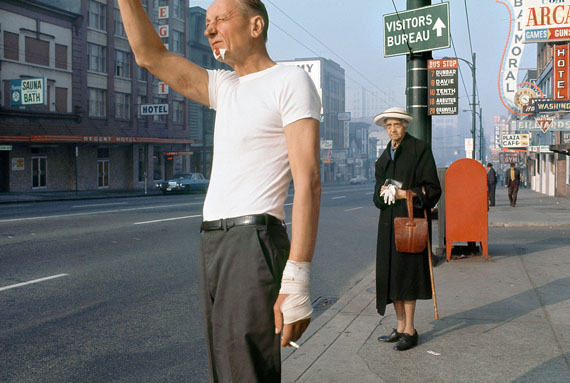
Courtesy of Equinox Gallery, Vancouver © Fred Herzog
"AUGEN AUF! 100 JAHRE LEICA FOTOGRAFIE"
Ausstellung: 9. März bis 5. Juni 2016
Die Leica-Kamera hat den Blick auf die Welt verändert. Für immer: Der fallende Soldat von Robert Capa, der Pfützenspringer von Henri Cartier-Bresson, der Kuss am Times Square von Alfred Eisenstaedt, die vor Napalm flüchtenden Vietnamesen von Nick Út, die sowjetische Flagge auf dem Berliner Reichstag von Jewgeni Chaldej – diese berühmten Fotografien sind alles Leica Bilder und haben sich tief in unser kollektives Gedächtnis eingebrannt. Erst die Kompaktheit und innovative Technik der Leica hat Fotografien wie diese ermöglicht. Die Vorgänger der Leica – in der Regel klobige, schwere Kameras – waren wenig handlich und für nur ein Foto pro Glasplatte ausgelegt. Es war kaum möglich, sie spontan einzusetzen. Vor der Leica glich Fotografieren eher einem Inszenieren von Wirklichkeit. Mit der Kleinbildkamera von Leitz wurde spontanes Reagieren möglich sowie unbemerktes Fotografieren auf der Straße.
Dynamisierung, Demokratisierung, mediale Revolution – technischen Innovationen werden oft große kulturelle Veränderungen zugeschrieben. So auch der Erfindung der Leica vor 100 Jahren. Wie jedoch kann ein kleiner, schwarzlackierter Apparat solch‘ superlative Wirkung entfalten? Das Taschenformat, die Möglichkeit des Objektivwechsels, die leise Mechanik und kurze Verschlusszeiten ermöglichen den Fotografen völlig neue Einsatzmöglichkeiten, extreme Perspektiven und ungewöhnliche Spontaneität. Durch die Verwendung von Kinofilm wird das Fotografieren seriell, preisgünstig und für jeden zugänglich. Schnelligkeit, Freiheit und Leichtigkeit inspirieren Fotografen in ihrer Arbeitsweise und bedienen die Bedürfnisse einer dynamischen Epoche. Die bequem in der Manteltasche zu tragende Kamera ist Auslöser für eine gewaltige Bilderflut, eine immense Lust am Experiment und eine umfassende visuelle Erkundung der Wirklichkeit. So wird die Leica zum Gradmesser von Aufbruch, Tempo und ästhetischen Neuerungen und bleibt ein Mythos bis ins digitale Zeitalter.
Die Ausstellung "AUGEN AUF! 100 JAHRE LEICA FOTOGRAFIE" beleuchtet in sechzehn Kapiteln Aspekte der Kleinbildfotografie: Von journalistischen Strategien über dokumentarische Ansätze bis hin zu freien künstlerischen Positionen. Sie verdeutlicht erstmals aus kunst- und kulturgeschichtlicher Perspektive, wie sich das fotografische Sehen im 20. Jahrhundert durch das Leica Kleinbild verändert hat. Mehr als 300 Fotografien aus internationalen Sammlungen und Museen sowie Zeitschriften und bedeutende Fotobücher belegen die unterschiedlichen Aspekte der Leica Fotografie ab Mitte der 1920er-Jahre. Die Ausstellung ist somit auch eine Stilgeschichte des Mediums von der klassischen Moderne bis zur postmodernen Vielfalt der Gegenwart, vom Neuen Sehen über die "Photographie Humaniste" bis hin zum Modebild, von der "subjektiven Fotografie" über die Autorenfotografie bis zur Street Photography und künstlerischen Fotografie unserer Tage.
In der Ausstellung präsentiert das Kunstfoyer München Arbeiten von international renommierten Leica Fotografen wie Alexander Rodtschenko, Henri Cartier-Bresson, Robert Capa, Christer Strömholm, Bruce Davidson, F.C. Gundlach, Fred Herzog, Robert Lebeck, William Eggleston, Will McBride, Paolo Roversi, René Burri, Thomas Hoepker, Bruce Gilden, Mark Cohen, Nobuyoshi Araki und vielen Weiteren.
Das erste Modell der Leica, deren Markenname sich aus den ersten Buchstaben von Leitz und Camera zusammensetzt, wurde im März 1914 vom Feinmechaniker und Hobbyfotografen Oskar Barnack fertiggestellt. Bereits ihm gelang es, packende Bildmotive auf einen 35-Millimeter-Kinofilm zu bannen. Dabei hatte Barnack das im Kino gebräuchliche Negativformat auf 24 x 36 mm verdoppelt und so einen weiteren für die Kleinbildfotografie des 20. Jahrhunderts verbindlichen Standard geschaffen. Allerdings konnte Ernst Leitz II, damals Chef des im hessischen Wetzlar beheimateten Unternehmens, die serielle Produktion und Markteinführung der Kamera erst zeitverzögert 1925 – nach dem Ersten Weltkrieg – realisieren.
Die Ausstellung wurde von Hans-Michael Koetzle kuratiert und bereits mit großem Erfolg in Hamburg, Frankfurt am Main, Berlin und Wien gezeigt. Die Münchner Station im Kunstfoyer überrascht durch weitere, zuvor nicht gezeigte Arbeiten u. a. von Hans Saebens, Werner Bischof, Paul Wolff oder Gérard Castello-Lopes.
Begleitend ist im Kehrer Verlag ein umfangreicher Katalog erschienen: 562 Seiten, ISBN 978-3-86828-523-9, Preis: 98 €�
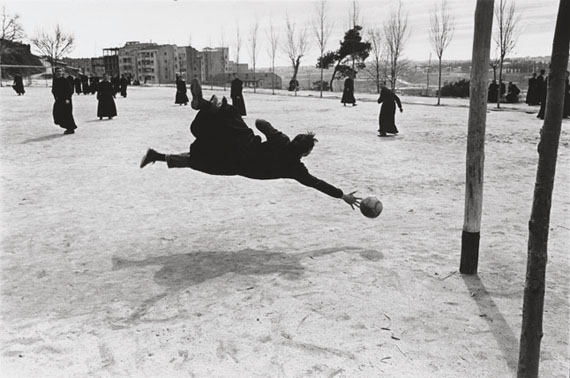
© Ramón Masats